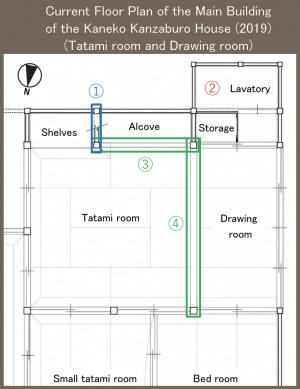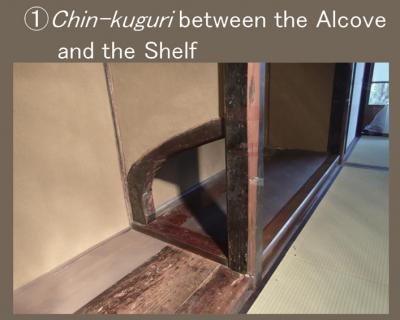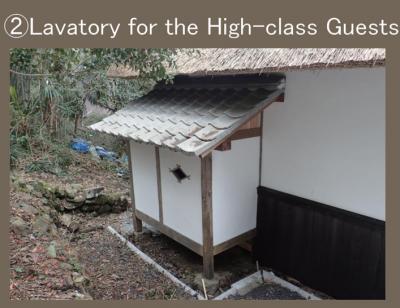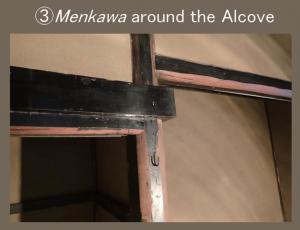本文
【金子勘三郎家】 パネル5(Part 5)
↵
其の五 接客の場としてのザシキ
床の間の造りと上客用の便所
一般的に座敷は、接客用の上質な部屋とされています。
金子勘三郎家主屋でも、竿縁天井(※1)を張り、床の間を設け、床の間と床脇の間(1)には「狆くぐり」(※2)を取り入れるなど、趣向を凝らした造りがみられます。
また、「ショイン」の奥(2)には「ベンジョ」があり、金子勘三郎氏への聞き取り調査では「カンベンジョ(上便所)」と呼ばれていたことからも、上客用に特別に作られたものと考えられます。
用材の使い分け
当家主屋の「ザシキ」では、床の間廻り(3)や「ショイン」との境の鴨居(4)に杉の面皮材(※3)が使用されています。
また、柱についても「ニワ」廻りにはクリやスギ、「オイエ」廻りにはケヤキやヒノキが用いられているのに対し、「ザシキ」廻りにはアテビ(※4)が多用されており、住人の居住空間から客間へ向かうほど、上質な用材を取り入れていることがわかります。
このことは、床の間の造りや上客用の「ベンジョ」の存在からも、佐渡奉行所の役人といった上客を迎え入れるという重世話煎の家として、他の部屋との差を明確に示すためと考えられます。
- ※1 竿縁天井
- 部屋の天井に横木を通し、その上に一方向に天井板を張ったもの
- ※2 狆くぐり
- 床の間と脇床の仕切り壁の下にある穴「狆」とは奈良時代に朝鮮半島から聖武天皇へ送られた犬のことであり、江戸時代には各地の大名や貴族達に珍重され、「狆」がくぐれるような隙間としてこの名がつけられた
- ※3 面皮材
- 角を皮付きで丸のまま残した用材で、高級材として用いられることが多い
- ※4 アテビ
- 和名は「ヒノキアスナロ」で、佐渡では「アテビ」と呼ばれ、水に強く、香りも良いことから高級建築材として用いられている
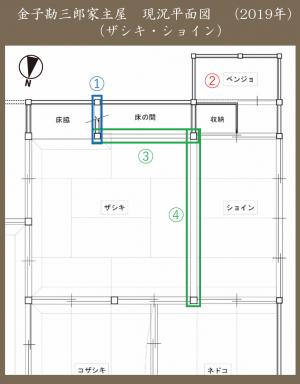
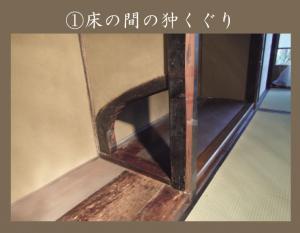
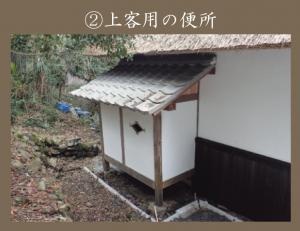
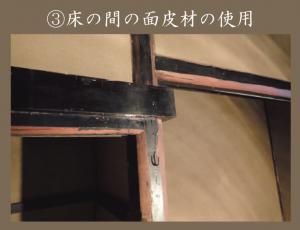
Part 5 Zashiki, a Place for Receiving Guests
Structure of the Alcove and the Lavatory for Upper-class Guests
Generally, a zashiki is considered to be a luxurious tatami room for receiving guests.
- In the main building of the Kaneko Kanzaburo House, we can see the elaborate construction, such as a coffered ceiling*1, an alcove, and a decorative hole shaped called a chin-kuguri*2, meaning a doorway for the Japanese Chin dog, between the alcove and the shelves (1).
Also, in the back of the shoin drawing room (2), there is a lavatory. According to an interview with Mr. Kaneko Kanzaburo, the lavatory was called the kanbenjo (literally meaning “upper lavatory”), which implies that it was specially built for upper-class guests.
Use of Different Types of Materials
In the zashiki tatami room of the main building, cedar trimming with rounded edges in a style called menkawa*3 are used around the alcove (3) and the doorframe (4) on the border of the drawing room.
As for the pillars, atebi*4 (hinoki cypress) is mainly used around the tatami rooms, whereas chestnut and cedar trees are used around the niwa (dirt floor area), and zelkova and white cedar are used around the oie (living room). It can be seen that the quality of materials used improves as we move from the living area to the room for receiving high-class guests. It can be found that the materials which were used became better as we move from the living area to the room for receiving high-class guests.
The structure of the alcove and the existence of the lavatory for high-class guests clearly distinguishes this section of the house from other rooms and implies that the village head’s house was a place where high-class guests such as officials from the Sado Magistrate’s Office were welcomed.
- *1 Coffered ceiling:
- a ceiling decorated with a series of sunken panels in the shape of squares.
- *2 Chin-kuguri:
- a hole in the bottom of the partition between the alcove and the shelf. It is called a chin-kuguri, meaning “door for a Chin” because the gap is the size that a Japanese Chin could squeeze through. The Japanese Chin refers to a dog breed sent to a Japanese Emperor from the Korean Peninsula during the Nara period (710-794). It was treasured by lords and aristocrats in various parts of the country during the Edo period.
- *3 Menkawa-zai:
- materials with rounded corners that retain their natural texture, which are used as high-grade materials.
- *4 Atebi:
- wood from a type of Japanese cypress tree. In standard Japanese, this tree is called hinoki asunaro, but on Sado Island, it is called atebi. It is used as a high-grade building material for its water resistance and pleasant fragrance.
